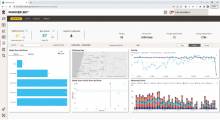Alift truck can be serviced 100% correctly, but if the technician and the underlying software used for work order management are not capturing the reasons and categories for each repair, you may be missing out on potential future savings.
That’s because careful technician coding and notes on repairs drives better data insights, says Adam Carraway, senior manager of consultative insights with Hyster Company.
Whether done with in-house teams, dealer technicians or third-parties, the proper coding and categorization of repairs enables service analytics, Carraway explains.
“The main thing is identifying those that are considered avoidable and those that are considered normal planned maintenance. That’s an important distinction track, and certainly not every operation doing its own maintenance is capturing that data point” says Carraway. “Coding those events properly allows us to analyze for trends and identify opportunities for operator coaching, or for solutions we might have within our equipment options, which would help lower their cost of ownership.”
Hyster, like other major lift truck vendors, offers service and maintenance options to its customers, from more basic plans to an advanced tier that includes data analysis and insight services. That’s where proper coding in work order management software sets the foundation. For a company running their own in-house service, it might be some type of computerized maintenance management system (CMMS).
“It’s the work order management system that’s capturing the life cycle of all service events,” says Carraway.
For end-users, Hyster’s fleet services technology includes web-based access to service history, costs, scheduled service events, and invoices or other records. An “Optics” option includes service analytics and recommendations from Hyster into everything from trends on cost per hour to run trucks, to unplanned repairs, to tracking hours on the equipment to see if certain trucks are underused or overused. “We can spot opportunities for equipment rotation within a fleet,” says Carraway.
Overall, the key goals in fleet management are to improve uptime, while lowering the total cost of ownership (TCO), says Carraway. Small steps identified with analytics of services data can help with either goal, he adds, especially when it comes to avoiding unnecessary repairs. Here is where analysis can reveal issues like flat-spotted tires, which can be related to operator behaviors like aggressive cornering or braking, or other issues like certain parts breaking faster than average for comparable trucks.
“Everyone knows about impacts and the importance of avoiding them, but other trends are harder to notice, like a flat spotted wheel or damaged pedals,” says Carraway. “Sometimes armrests get pulled too hard, and we start seeing those break. We analyze the data and determine, ‘hey, we have a common operator behavior here that’s leading to certain issues, here are some suggested solutions.’ We might offer an enhanced component or truck option to help mitigate the issue, or it might be as simple as some operator training or coaching. Or if impacts are becoming more of an issue, we might recommend telemetry.”
The as-serviced history of the fleet also drives accurate metrics about the cost to maintain trucks and what percentage of repairs are classified as avoidable. Among fleet services customers, on average, about 15% of all services events are avoidable repair events, says Carraway, though some clients might begin with that ratio as high as 35%, with the aim of working it down to below average.
“We have some customers who have been in our program and are as a low as 5% on their percentage of avoidable service events,” adds Carraway. “You want that metric to be between 5% and 15%. If it’s over 15, there are likely ways to improve it. It can be eye opening for our customers when they start to track this metric, and also compare differences across sites. We can show a customer, this site is in the bottom 5% of your network in terms of avoidable repairs. That gets their attention and helps drive positive changes.”
Article topics










